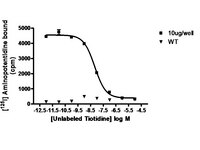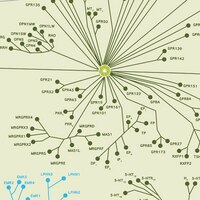HTS086M Sigma-AldrichChemiSCREEN™ Human H2 Histamine Receptor Membrane Preparation
Human H2 GPCR membrane preparation for Radioligand binding Assays & GTPγS binding.
More>> Human H2 GPCR membrane preparation for Radioligand binding Assays & GTPγS binding. Less<<Prodotti consigliati
Panoramica
| Replacement Information |
|---|
Tabella delle specifiche principali
| Species | Host Cells | Protein Target |
|---|---|---|
| Human | Chem-2 | H2 |
| References |
|---|
| Product Information | |
|---|---|
| Format | Membranes |
| Presentation | One package contains enough membranes for at least 200 assays (units), where a unit is the amount of membrane that will yield greater than 7-fold signal:background with 125I-labeled Iodoaminopotentidine at 0.65 nM Liquid in packaging buffer: 50 mM Tris pH 7.4, 10% glycerol and 1% BSA with no preservatives. Packaging method: Membranes protein were adjusted to 1 mg/mL in packaging buffer, and dispensed at 1 mL/vial. Vials were rapidly frozen, and stored at -80oC. |
| Quality Level | MQ100 |
| Physicochemical Information |
|---|
| Dimensions |
|---|
| Materials Information |
|---|
| Toxicological Information |
|---|
| Safety Information according to GHS |
|---|
| Safety Information |
|---|
| Storage and Shipping Information | |
|---|---|
| Storage Conditions | Maintain frozen at -70°C for up to 2 years. Do not freeze and thaw. |
| Packaging Information | |
|---|---|
| Material Size | 200 units |
| Transport Information |
|---|
| Supplemental Information |
|---|
| Specifications |
|---|
| Global Trade Item Number | |
|---|---|
| Numero di catalogo | GTIN |
| HTS086M | 04053252470981 |
Documentation
ChemiSCREEN™ Human H2 Histamine Receptor Membrane Preparation MSDS
| Titolo |
|---|
ChemiSCREEN™ Human H2 Histamine Receptor Membrane Preparation Certificati d'Analisi
| Titolo | Numero di lotto |
|---|---|
| CHEMISCREENTM MEMBRANE PREPARATION RECOMBINANT HUMAN H2 HISTAMINE RECEPTOR - 2108258 | 2108258 |
| CHEMISCREENTM MEMBRANE PREPARATION RECOMBINANT HUMAN H2 HISTAMINE RECEPTOR - 2366628 | 2366628 |
Riferimenti bibliografici
| Panoramica dei riferimenti bibliografici | Codice d'identificazione nel Pub Med |
|---|---|
| Novel insights into histamine H2 receptor biology Del Valle, J and Gantz, I Am J Physiol, 273:G987-96 (1997) 1997 | 9374694
 |
| Distribution, properties, and functional characteristics of three classes of histamine receptor Hill, S J Pharmacol Rev, 42:45-83 (1990) 1990 | 2164693
 |









